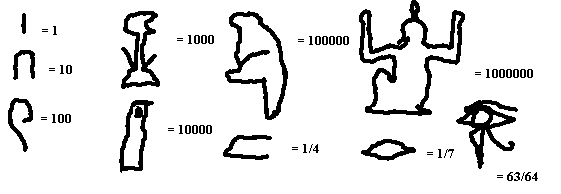
About 3000 BC, the ancient Egyptians used hieroglyphics (picture writing) to write numerals.
This system was based on 10. But it did not include a zero symbol, nor did it use the principle of place value. The Egyptians formed numerals by putting basic symbols together. With this system, Egyptians could put symbols in any order, because the value of a symbol did not depend on its position.
Hieroglyphics is a form of writing in which picture symbols are used to represent ideas and sounds. The word hieroglyphics comes from two Greek words that mean sacred carving. Hieroglyphics most often refers to the writing used in ancient Egypt. However, forms of picture writing were also used in other ancient cultures, notably by the Hittites, who lived in what is now Turkey, and by the Maya and Aztec Indians who lived in Central America.
The ancient Egyptians used hieroglyphic writing for more than 3,000 years. They used such writing mainly for religious inscriptions on temples and stone monuments and to record the words and deeds of royalty. In fact, the Egyptians sometimes called their writing the words of God. The inscriptions were written or carved by highly trained men called scribes. After the AD 300's, the Egyptians replaced hieroglyphic writing with a simpler alphabet, and knowledge of these symbols was soon lost. The meaning of hieroglyphics remained a mystery until the early 1800's, when scholars deciphered the writing.
This is an example of hieroglyphics. They are: rod=1, cattle hobble=10, coiled rope=100, lotus flower=1 000, finger=10 000, tadpole=100 000, god with raised arms=1 000 000.

The number 123 would be written:

with the numbers increasing in size from left to right.